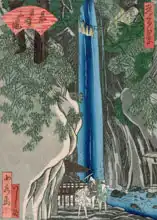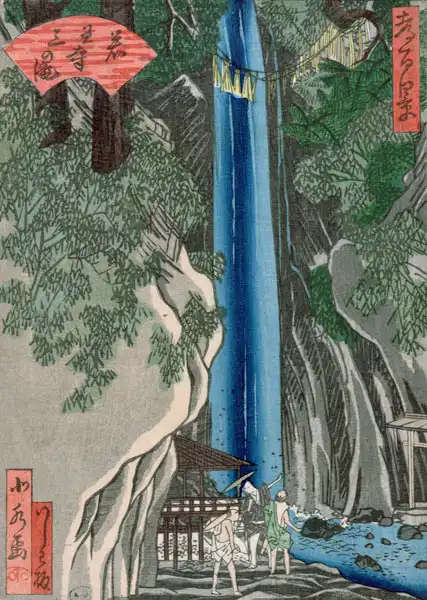About this finishing
Print. The image is printed on the top quality 10-ink HP Z9PS printer on HP matte 270 g / m2 paper. You can choose any size to an accuracy of 1 cm. A margin of 5 cm around the image is added to the size of the motif.


You can find a detailed description about our finishings
here.
The Waterfall
Date:
19th centuryMedium:
coloured woodcutLocation:
Bibliotheque des Arts Decoratifs, Paris, FranceThe painting shows a colourful Japanese woodcut depicting a waterfall scene. A waterfall with azure blue water falls from a great height between green trees. At the bottom of the waterfall are wooden buildings and small figures that may be people. The scene looks peaceful and is set in a mountain environment. The style of the painting is typical of traditional Japanese art.
This description was created by artificial intelligence, please be indulgent.
Hokusai painted picture The Waterfall in 19th century. Prevailing color of this fine art print is vivid and its shape is portrait. This art piece is located in Bibliotheque des Arts Decoratifs, Paris, France. This image is printed on demand - you can choose material, size and finishing.
Katsushika Hokusai (1760-1849). The Japanese artist, painter of ukiyo-e (pictures of the fleeting world) and illustrator known today mainly for his series 36 Views of Mount Fuji. He was born in Edo (now Tokyo). His most used technique was woodcut, which he subsequently transferred using colours onto paper or silk. The technique originated in the 8th century in China, and in the 17th century, it began to spread to Japan. Using this technique, officials, the life of upper classes, cities, travels, etc. were captured. The most famous representative of this series is a painting titled
the Great wave of Kanagawa. This xylograph was printed in approximately 5000 copies (therefore, there are different versions of the image). The image does not capture a tsunami, but rather okinami - literally translated, a folded wave on the open sea. Hokusai studied Japanese, Chinese, French and Dutch artwork and developed a distinctive style, which broke through the traditional and preconceived notions of what was then a Japanese painting. His work has had a global impact, and especially affected
Impressionists.


